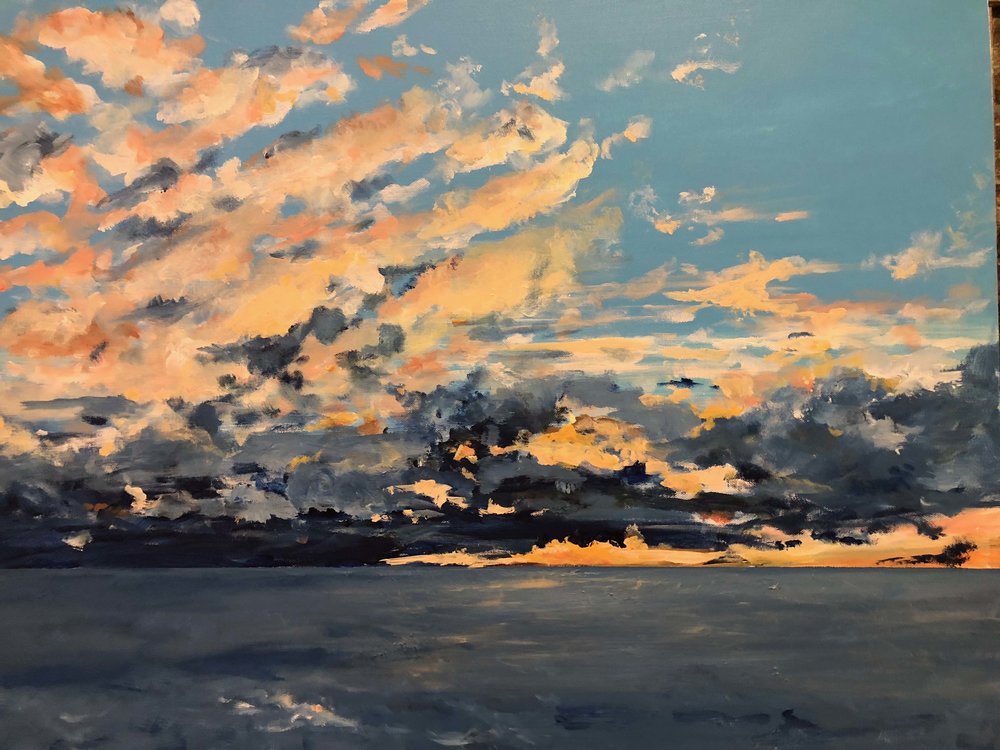ANN KRAUS: ABOVE AND BEYOND
Impressionistic events in nature naturalistically depicted and those surreally suggesting natural events are the dual streams in Ann Kraus’s work in Above and Beyond. The relationship between these modes of expression rests upon an amorphous middle ground stylistically and formally sourced. Form originates from actual iterations that structure and compound inspiration.
There’s a broad range to Kraus’s depictions of the sky. The artist has traveled, and with her she has always taken her fascination with the boundless upper reaches. She sketches them endlessly but also employs a camera to document a sequential engagement with her subject matter, so as not to miss out on especially choice impressions. It’s in the active and the after-the-fact engagement that her subject reveals itself. The implicit rendering of nature not specifically circumscribed by the departure point of a physical landscape into realms of cloudscape are at the heart of Kraus’s work. Nature is open to as much interpretation as the will finds possible. The print allows for a certain finality of gesture that gives presence to the immense force at hand in the natural event without the illustrative stagecraft in picturing each cloud system, the greater sky around it, and the ocean or land close by. It is compared to painting a view through a microscope rather than a dramatic projection in a theater, though in no way less sublime. In choosing the elements that she does, Kraus achieves a series of elliptical moments that range from tender to expansive. One can read a single impression into these images or one can wander esthetically around each one, seeking alternate impressions, allowing each one its power to affect over others.

Above is contextually idealistic. The artist’s intimation that the viewer, like herself, should “look up” suggests a willingness to commit ourselves to a higher aesthetic, and whether that translates to images or to beliefs, it’s still provisionally indicative of a willfully altered state of mind. Humanity spent a millenia looking up, so it’s nothing intrinsically new, but to encourage our sense of wonder is an important artistic role to which Kraus happily submits. It makes me think of the famous quote from Hamlet, when encountering the skull of his father’s former court jester, he so solemnly states “There’s more to heaven and earth than is dreamt of in your philosophy!” Though with far less bathos, Kraus interprets this edict as a means of freeing the mind from its petty everyday minutiae to enjoy the clouds above.
By comparison, Beyond is introspective and cerebral, immersing the viewer in a universe of interior meaning that embodies neither an idealism nor its absence or opposite. The details in each work from this series are generally less important as sensory indicators. Each image is like a petri dish where all the myriad as yet unobserved matters of a teeming life are unveiled. Looking beyond is not merely an indicator as to the augury of the mysterious, but an option to examine with deft attention the activity of essential materials.

Ann Kraus is a portrayer of ineffables. Her paintings of clouds and her abstract prints both skirt the edges of what is traditionally considered proper subject manner. She is not just depicting what is there, but is denying the importance of more prosaic and provisional subjects, such as everyday scenes of domestic or workaday life, or those in which the body, clothed or nude, as a connection between artifice and our personal narratives. Her scenes have no people in them, they depict places with no structure but that which the viewer can bring to them. We are invited in one circumstance to join her in reading clouds, seeing the same symbolic story she lived. In the other, we are given keyholes that look out upon a greater universe, in a medium not normally given to causality. It’s important to consider not merely the symbolic or speculative quality of her work, but how formal accomplishments allow the works to demand more or us. The complete oeuvre represented in “Above and Beyond” is easily more than the sum of its parts, because their combination does not create a resulting theory or solution to answer all plausible questions, but alternately confronts the sources of inspiration and the products of the imagination. They coalesce together, alternating between the seen and the perceived. Both of them enlarge what we understand as the definition of “having an experience” and the knowledge they access for us, though not immediately quantifiable, is no less important for that fact. Together they set the mind dancing on the edge of its next range of questions.


Comments